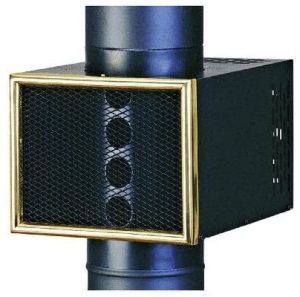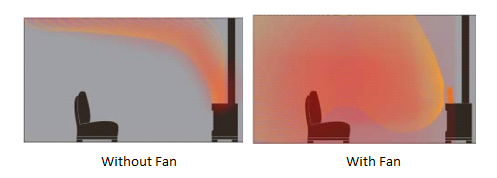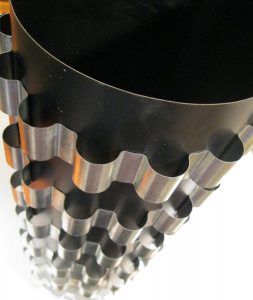Wood stoves are a preferred choice in the areas of world where wood is easily and cheaply available. As the environmental concerns are rising and layman is starting to get conscious about sustainability issues, engineering and scientific community has started to devote lot of time and energy on making devices more efficient.
Efficiency is nothing but the ratio of output to input. The difference between input and output is nothing but wastage or losses. So, efficiency can be increased either by increasing output or reducing input. Or in simple words, reducing losses.
In case of wood stoves, the efficiency can be increased by obtaining more heating from the same amount of wood that is being burned or reducing wood consumption for the same heating effect.
Significant amount of heat is wasted in the wood stoves, which goes up through the smoke stack in the form of hot flue gases.
Heat reclaimers help to convert this waste heat into the useful heat by the way of proper air circulation or by radiation. Many a times, the space near the wood stove is hot while space some distance away is still cold. This happens because of lack of air circulation. Hot air goes up by convection and settles towards the ceiling. Air quite away from wood stove does not get any heat. Fans help to circulate the hot air in the room reducing wastage of heat.

Below discussed are various types of heat reclaimers that are available on the market.
Contents
Heat Exchangers or simply called heat reclaimers
The heat reclaimers, also called stack robbers, have a special attachment that fits in the stove pipe in the room. The pipes of reclaimer pass through the stack where they come in contact with flue gases on their outside and get heated.
Cold air in the room is forced through the pipes of reclaimer with the help of a fan. The air gets heated when it comes into contact with the hot pipes. Thus, the hot air is force circulated in the room.
The waste heat in the flue gases is thereby reclaimed and temperature of flue gases drops. Too much drop in the temperature can cause condensation of flue gases on cold surfaces of chimney. Creosote are unburned charcoal particles that attach on the inside of chimney stack. They are dangerous and can cause chimney fires. To tackle this, the fan of reclaimer is thermostatically controlled. It starts at a higher set point temperature and stops when the temperature drops to the lower set point.
These types of reclaimers can be used regardless of type of flue pipe. That means, they are suitable to use for both double wall and single wall pipes.
Heat radiators
These are nothing but extended surfaces attached on the heat pipe. They work like fins, since they increase surface area of flue pipe. These devices help to radiate heat in the room.
The radiators are recommended with only single wall type flue gas pipes.
These types of heat reclaimers are not very popular in the market and very limited product ranges are available.
Heat Powered stove fans
The stove fans have a unique design. Stove tops have temperature of around 400 °F. Fans are kept on stove top. Fan bottom is in contact with this hot surface while top of the fan (heat sink) is in contact with cold room air. Thus, temperature difference is created between two points of fan body. This is used to generate an EMF that drives a small electric motor. Fan blades mounted on this motor shaft thus force circulate the air in the room. So, the stove top fans operate on the principle of Seebeck effect (thermoelectric generator).
These fans have many advantages. They help to circulate hot air in the room. They can be directed in whichever direction we want, just by directing the fan blade to required direction.
This hot air can be targeted towards the areas occupied by people. These fans do not need additional electricity. Moreover, because of their aesthetic design, they look attractive. The fans are available in variety of options. Some fans have two blades while most have four. Fans with different sizes depending upon flow rate are available.
Electricity powered fans
The wood stove blowers and fans powered by electricity can also be used as heat reclaimers. Even though, they consume electricity, they have much higher air flow displacement capacity than heat powered fans. Large rooms where heat powered fans are not sufficient, electric blower and fans are ideal choice. Since, they have higher RPMs, the noise is also more.
Ceiling fans can also be used along with wood stoves. They push down the warm air which goes up by convection. They help circulate the hot air in the room.
Below are some of the Heat Reclaimers available on Amazon:
HY-C MH-8R Magic Heat Bottom Crimp Heat Reclaimer

The ‘Magic Heat’ heat reclaimer is popular reclaimer on Amazon. Their unique design has ten air vents that pass through the path of flue gases and help the air to pickup maximum heat. At the same time, the open inner casing helps to increase the diameter of flue gas stack. So, the flue gases pass with minimum restriction. Built-in soot scraper cleans tubes internally allowing for maximum heat transfer.
These are specifically designed for wood burning stoves and have 225 CFM fan that blows hot air into the room with two operating modes. The fan needs 110V power supply. They claim to be the only UL listed heat reclaimer on the market.
On the cost side, they are quite expensive. Good aesthetic and easy installation and maintenance make them popular choice of heat reclaimer.
Vogelzang Heat Reclaimer

Vogelzang Heat Reclaimers have simple design. The tubes of the heat reclaimer pass through the flue pipe, getting directly in contact with hot flue gases. The fan forces cold air through these tubes, which in contact with hot tubes gets delivered in to the room.
These reclaimers have a nice look and steel construction. The fans are thermostatically controlled and thus help to reduce creosote formation, switching ON and OFF on set temperatures. Compared to ‘Magic Heat’ heat reclaimers, the design and construction is simple. They do not have built-in soot scrappers and need periodic maintenance.
GALAFIRE eco-heat powered wood stove fan

This is quite popular wood stove fan on Amazon. It comes in two different models, N430 and B530. One with four blades and the other with three.
The fan is believed to operate quietly and blows hot air with maximum velocity of 380 feet per minute. The fan is made of anodized aluminium material and weighs less than a kilogram.
The second version, though slightly expensive, has three blades and runs with speed more than 950 RPM. On the other hand, fan N430 runs with speed more than 750 RPM.


Detex Wood stove Radiator

These are set of six 28 ga. Steel strips 1 ½“ wide, fit on the 8” stove pipe along the circumference, with snap action. They have total area of 252 sq. inch. The steel strips when in contact with stove pipe, get heated, and become almost equally hot as stove pipe itself. The radiators are equivalent to 12”x21” steel sheet at a temperature of 300-500°F radiating heat on both the sides.
They do not need any electricity or periodic maintenance. Installation is quite easy. They are cheap compared to other types of heat reclaimers. Thus, they simply increase surface area of stove pipe, which helps to increase air convection and radiation. These can be used independent of type of fuel, but are most suitable for single wall pipes.
Summary
The heat reclaimers help to extract heat from the stove pipe which otherwise would have been wasted. Simplest tool to check whether heat reclaimer is doing its job or not is ‘thermometer’. Users can check the temperature of stove pipe before and after the heat reclaimer and see whether there is drop in temperature or not. More the drop, more the heat is being extracted. Too much drop in the temperature may also cause creosote which might be dangerous and can cause chimney fires.
Even-though, manufacturers claim that their device and stove pipes need little or no cleaning and maintenance, users must schedule to clean the pipes at-least once every month. This policy is always good for one’s safety.
The reclaimers are not very cheap. Users can get confused looking at the variety of reclaimers available on the market places.
One can select any type of heat reclaimer or their combination depending upon the need and budget.
For larger rooms, stove pipe radiators may not be effective. In this case, heat reclaimers or heat powered fans should be chosen. Smaller room can benefit from radiators. Installation and maintenance can also be a criterion of selection.
Heat reclaimers such as ‘Magic Heat’ or ‘Vogelzang’ have specific installation instructions. These also need periodic maintenance. On the other hand, heat powered fans and radiators need very less maintenance. These types are very easy to install.
At the end, selection of wrong reclaimer may only be a wastage of money.
